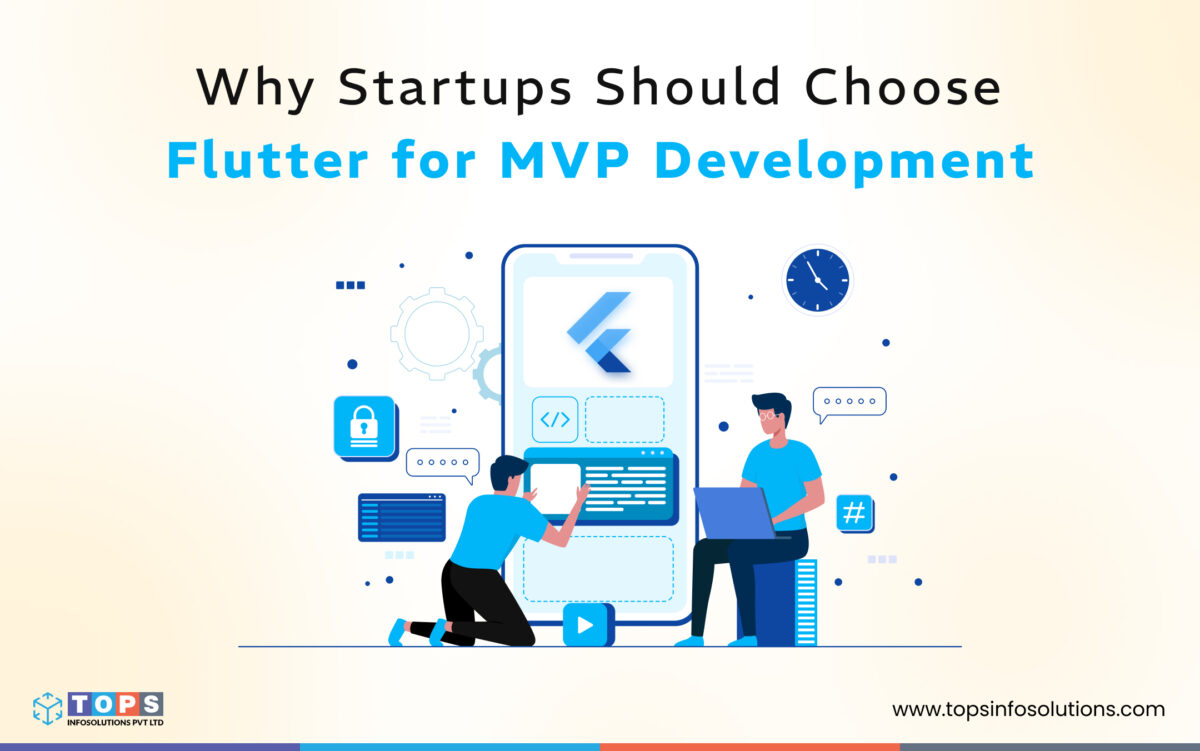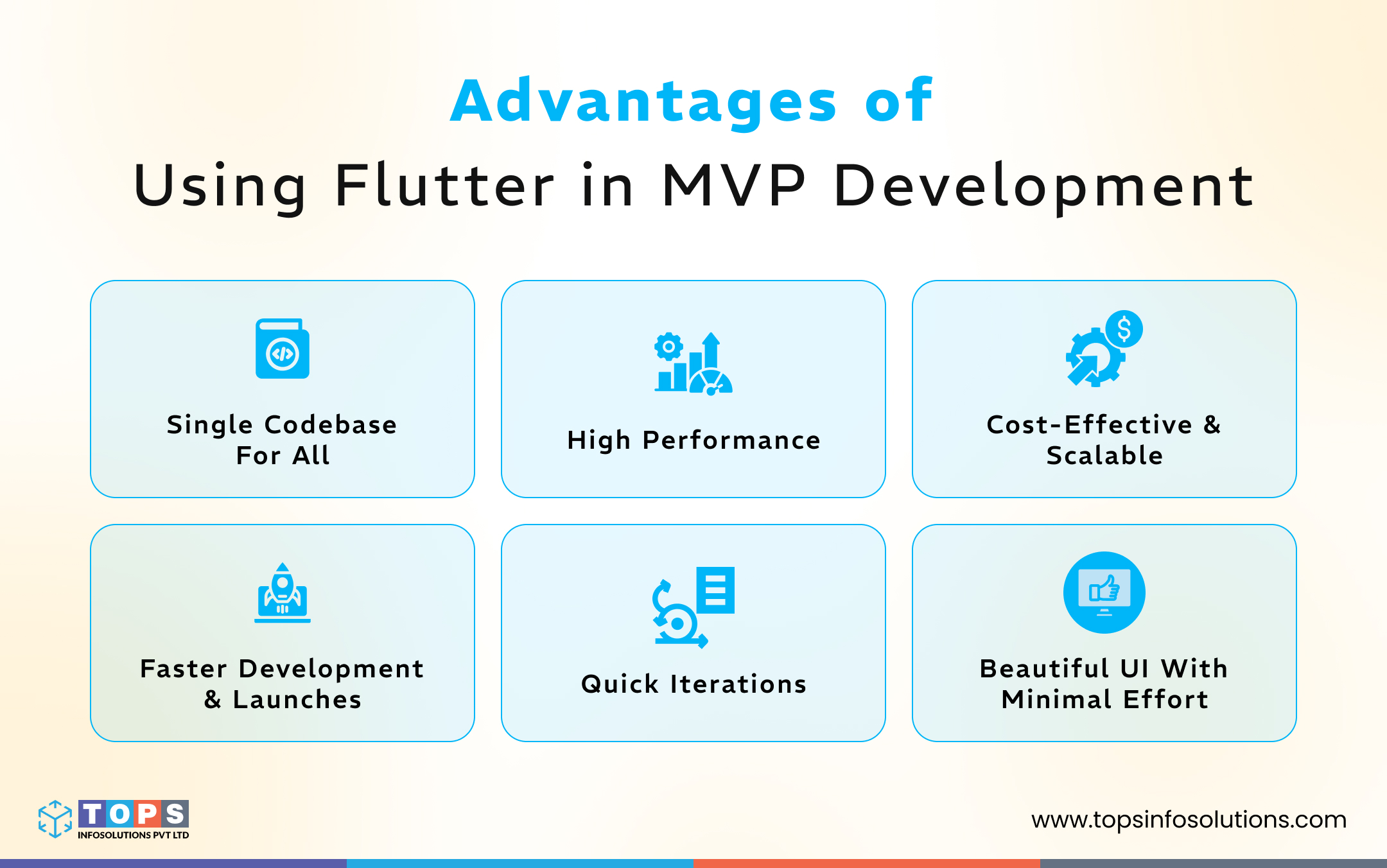Table of Contents
Benefits of Flutter for Startups Building MVPs

As a startup, if you’re considering a Minimal Viable Product (MVP) to fast-track your app idea, you’re already on the right path.
The next big question is, “What’s the smartest way to build it?”
The answer: Flutter.
Research indicates that Flutter is the most widely used cross-platform mobile framework among global developers, with a usage rate of 46%.
Wondering why?
In this blog, we’ll cover everything you need to know about why Flutter is your ultimate framework for creating your MVP.
What is MVP?
When you’re building a new app, it’s tempting to add every feature you can think of to make it stand out. But as a startup, you have limited resources and time. The risk of building something users don’t need is real. That’s where an MVP (Minimum Viable Product) comes in.
An MVP is a simplified version of your product that includes only the must-have features necessary to solve the primary problem. Instead of perfection, the aim here is to build a workable first version you can launch quickly, test with real users, and improve based on feedback. There are three takeaways to understand the motive behind the MVP development process:
- The product is built to address the target audience’s needs
- It solves their primary pain points
- It saves money on full-fledged development
This makes it clear as to why startups love MVPs:
- You’re building only what’s essential,
- You’re making a faster launch possible,
- You’re getting real feedback before investing big, and
- You’re building a product that has an investor appeal. A working MVP is far more convincing than a pitch deck.
Read More: How to Build a Successful MVP – A Complete Guide
What is Flutter?
Flutter is an open-source app development framework created by Google that enables you to build beautiful, high-performance apps for mobile, web, and desktop platforms, all from a single codebase.
At its core, Flutter uses the Dart programming language, which is optimized for client-side development. Introduced in 2018, Flutter allows developers to build fast and visually consistent applications for iOS app development, Android app development, and web app development, along with support for desktop platforms like Windows.
An important point to remember is that, unlike many other cross-platform tools, Flutter doesn’t rely on native components. It instead uses its own high-performance rendering engine. This gives developers full control over UI and ensures consistent performance across platforms.
Key components of Flutter
- Flutter SDK: Flutter provides a Software Development Kit that provides the tools necessary to compile your code into native machine code for iOS and Android.
- Dart Programming Language: Flutter apps are written in Dart, a language developed by Google. The language is designed to support applications with a strong emphasis on exceptional design and user experience.
- Widgets: Flutter provides a rich set of pre-designed widgets that allow developers to build complex UIs effortlessly.
There are numerous reasons why most startups turn to Flutter for MVP app development. Let’s check them out in detail.
Benefits of Choosing Flutter for MVP
The MVP app development process is all about speed, efficiency, and testing your idea most cost-effectively. But the framework you choose can decide the fate of your launch. That’s where Flutter can make a difference.

1. Single codebase for all
One of the benefits of Flutter app development is that it allows you to write a single codebase that works across iOS, Android, web, and even desktop apps. For a startup, this means avoiding the need to hire separate teams for iOS and Android, web, and desktop apps. You simply write once and deploy everywhere, saving both time and money.
This approach is particularly valuable for MVPs because you’re rewarded with speed. You can test your idea quickly with real users instead of spending months developing platform-specific apps. It results in less overhead, easier maintenance, and the ability to focus on improving features and user experience, rather than worrying about duplicating work across platforms.
2. High performance
Users expect smooth, responsive apps, and nothing kills early adoption faster than lag or crashes. This is an issue that many cross-platform frameworks face. Flutter shines here because it compiles directly into native code. This means your MVP can feel just as fast and smooth as a native app, giving users a polished experience from day one.
For startups, this is particularly useful. A high-performance ensures users have a positive first impression, which is essential for collecting feedback, retaining users, and attracting investors. Flutter delivers this without requiring multiple native apps, keeping the development lean and efficient.
3. Cost-effective & scalable
A startup works on a budget, especially if it is bootstrapped. You can only take measured risks, and MVP is the best way to play safe investment-wise. Why? For starters, hiring two separate development teams (iOS and Android) is often too expensive and leads to ongoing maintenance costs. Flutter solves this problem since you just need one development team and codebase, cutting the cost to develop an MVP in half.
Secondly, Flutter makes it possible to scale at the pace you want. An MVP should grow into a full product without needing to start from scratch. You can scale gradually, where you can build a lean version of your app today and later expand it with advanced features, backend integrations, or support for web without a complete rewrite.
4. Faster development and launches
Small businesses entering the mobile market often deal with time and budget constraints. The faster you build your MVP, the quicker you can validate the idea and attract investors.
Flutter helps with accelerating the development since its prebuilt widgets, powerful framework, and single codebase significantly reduce development time. For your startup, faster launches mean testing ideas earlier, reducing risk, and staying one step ahead of the competition.
5. Quick iterations
You’re building an MVP to test the initial solution amongst users and make changes according to their experiences. Understand that launching an MVP is just the beginning. Startups thrive on iteration, where you need to add what users love, remove what they don’t, and refine the experience in short cycles.
Flutter makes this easy. Thanks to its hot reload and modular architecture, you can test new ideas, fix issues, and push updates rapidly. Besides, these iterations happen simultaneously across iOS and Android.
6. Beautiful UI with minimal effort
User experience is always at the forefront of mobile apps, regardless of whether you’re building a full solution or just the core features. Flutter makes it possible to design a professional, visually appealing interface without needing a large design team or endless hours of customization.
It has an expressive and flexible UI toolkit, Skia, that allows developers to create visually stunning and high-quality apps that effectively position the MVP’s value proposition.
Flutter comes with a wide range of pre-built, customizable widgets that follow platform-specific guidelines. This means your app can look and feel like it was built natively for each platform, while still using a single codebase.
7. Growing community support
Finally, the best part of Flutter is that you’re never alone when it comes to facing challenges or being stuck. Choosing the right platform goes beyond just the technology. It also means choosing the right ecosystem around it. Flutter has one of the fastest-growing communities in mobile app development.
Since it is backed by Google and supported by thousands of developers, it has a strong repository of plugins, tools, and learning resources. This can prove to be incredibly valuable for startups. A growing community also means it’s easier to find developers who know Flutter, troubleshoot issues quickly, and make use of ready-made solutions instead of starting from scratch.
It also ensures the framework stays up-to-date with new features, integrations, and improvements, so your MVP isn’t stuck on outdated tech.
TOPS Helps You Build Smarter Apps with Flutter
Building an MVP is all about testing fast and scaling smart, and Flutter makes that journey smoother than ever. With its single codebase, high performance, and cost-efficiency, it’s clear why startups worldwide are choosing Flutter as their go-to framework for MVP development.
But choosing the right technology is only part of the equation. What really determines success is having the right Flutter app development company that understands startups and helps you to go from concept to launch with speed. At TOPS, we specialize in Flutter development and MVP builds tailored for startups.
